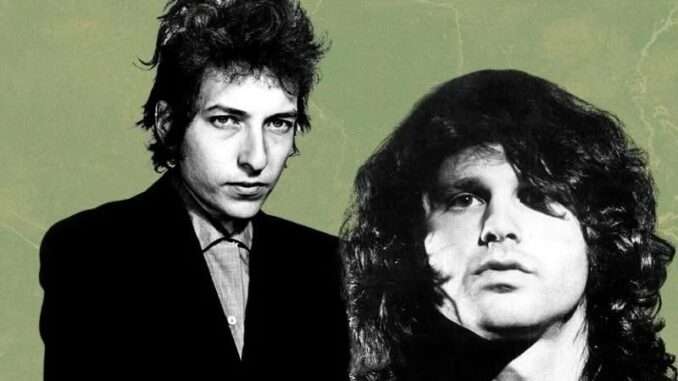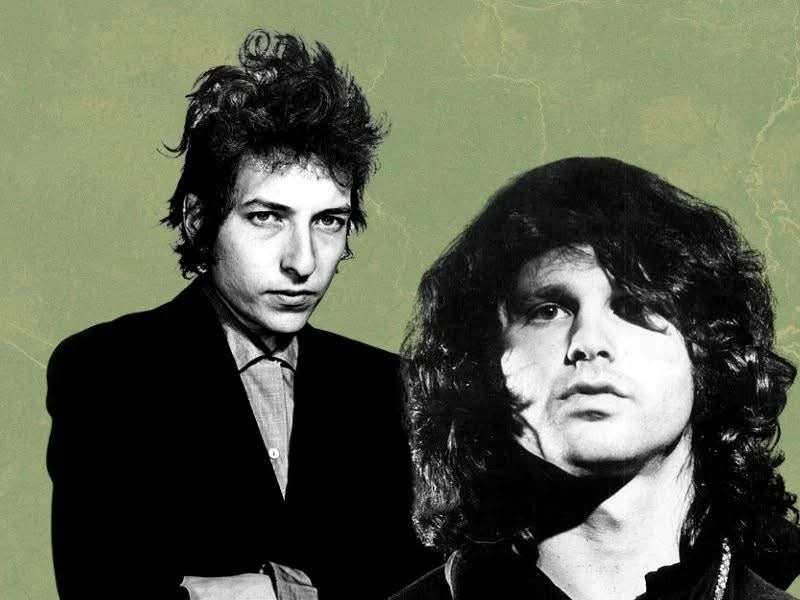
Two of the most influential voices in 20th-century music — **Bob Dylan** and **Jim Morrison** — may have come from different corners of rock history, but both shared an extraordinary gift for transforming words into emotional revelation. While their musical styles diverged, Dylan’s admiration for Morrison’s work has long fascinated fans of both artists. Known for his own poetic genius, Dylan once confessed that Morrison’s poetry and lyrics moved him in ways few others could.
“**Sometimes I just cry reading his stuff. It’s not sadness. It’s release,**” Dylan once said when reflecting on Morrison’s writing. That quote alone captures the depth of his emotional response — not one of grief, but of recognition. For Dylan, Morrison’s words touched the same raw, spiritual space that he himself had spent his career exploring. The connection wasn’t about imitation or influence; it was about shared purpose — the desire to turn human experience, pain, and beauty into something timeless.
Jim Morrison, the charismatic and complex frontman of **The Doors**, was not just a rock singer but a poet at heart. Long before fame, he filled notebooks with vivid imagery and philosophical musings, drawing inspiration from literature, mysticism, and existential thought. While critics often focused on his wild stage persona and controversial lifestyle, Dylan saw through that surface — recognizing in Morrison a brilliant artist wrestling with truth in its most unfiltered form.
Dylan’s respect for Morrison came from a place of artistic understanding. He described Morrison’s writing as “touching the spirit in a profound and often raw way,” acknowledging the emotional honesty that ran through his poetry. Where others saw rebellion, Dylan saw depth; where the public sometimes viewed chaos, Dylan perceived courage — the courage to write and perform without restraint, to confront the world’s contradictions with fearless vulnerability.
Both men shared an instinct for capturing the soul of their generation. Dylan’s verses chronicled the social and political unrest of the 1960s, while Morrison’s lyrics dove into the darker corners of consciousness and desire. Yet their intentions met at a crossroads of artistic truth. They both believed that art, especially words, could serve as liberation — a release from conformity and a passage into self-understanding.
It’s no surprise that Dylan’s appreciation of Morrison goes beyond mere respect; it’s almost spiritual. He recognized in Morrison’s work the same pursuit of meaning that had driven his own songwriting. Their shared emphasis on freedom — creative, emotional, and intellectual — formed an invisible bridge between them. Morrison’s verses like *“Cancel my subscription to the resurrection”* or *“There are things known and things unknown and in between are the doors”* echoed the same poetic spirit that made Dylan’s lyrics resonate across generations.
Despite public skepticism and the occasional dismissal of Morrison as more performer than poet, Dylan never wavered in his view. He saw Morrison as both clever and deeply artistic — a man unafraid to channel his innermost chaos into creation. That, to Dylan, was the true mark of an artist.
In a world that often separates poetry from rock music, Dylan’s recognition of Morrison’s artistry bridges that gap. It’s a reminder that poetry can live in a guitar riff, a verse shouted into a microphone, or a whisper written on a page. Both men blurred the lines between the spoken and the sung, between art and rebellion, between performance and truth.
For Dylan, reading Morrison’s poetry was more than admiration — it was a moment of release, a recognition of something universal and human. It was one poet saluting another, one seeker of truth acknowledging a kindred spirit. And in that, their legacies remain forever intertwined — not just as icons of an era, but as poets whose words continue to move hearts, decades after the music fades.
Leave a Reply